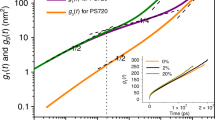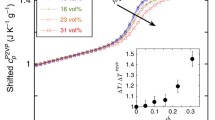Abstract
We present a unified constitutive model capable of predicting the steady shear rheology of polystyrene (PS)–nanoparticle melt composites, where particles can be rods, platelets, or any geometry in between, as validated against experimental measurements. The composite model incorporates the rheological properties of the polymer matrix, the aspect ratio and characteristic length scale of the nanoparticles, the orientation of the nanoparticles, hydrodynamic particle–particle interactions, the interaction between the nanoparticles and the polymer, and flow conditions of melt processing. We demonstrate that our constitutive model predicts both the steady rheology of PS–carbon nanofiber composites and the steady rheology of PS–nanoclay composites. Along with presenting the model and validating it against experimental measurements, we evaluate three different closure approximations, an important constitutive assumption in a kinetic theory model, for both polymer–nanoparticle systems. Both composite systems are most accurately modeled with a quadratic closure approximation.











Similar content being viewed by others
References
Advani SG, Tucker CLI (1990) Closure approximations for three-dimensional structure tensors. J Rheol 34(3):367–386
Aubry T, Razafinimaro T, Mederic P (2005) Rheological investigation of the melt state elastic and yield properties of a polyamide-12 layered silicate nanocomposite. J Rheol 49(2):425–440
Azaiez J (1996) Constitutive equations for fiber suspensions in viscoelastic media. J Non-Newtonian Fluid Mech 66:35–54
Banach M, Alexander Jr MD, Carraci S, Vaia RA (1999) Enhancement of electrooptic coefficient of doped films through optimization of chromophore environment. Chem Mater 11(9):2554–2561
Bird RB, Curtiss CF, Armstrong RC, Hassager O (1987) Dynamics of polymeric liquids. Wiley, Hoboken
Dinh SM, Armstrong RC (1984) A rheological equation of state for semiconcentrated fiber suspensions. J Rheol 28(3):207–227
Folgar F, Tucker CL (1984) Orientation behaviour of fibres in concentrated suspensions. J Reinf Plast Compos 3:98–119
Gao HW, Ramachandran S, Christiansen EB (1981) Dependency of the steady-state and transient viscosity and first and second normal stress difference functions on molecular weight for linear mono and polydisperse polystyrene solutions. J Rheol 25(2):213–235
Henson DJ, Mackay ME (1995) Effect of gap on the viscosity of monodisperse polystyrene melts: slip effects. J Rheol 39(2):359–373
Hoffman B, Dietrich C, Thomann R, Friedrich C, Mulhaupt R (2000) Morphology and rheology of polystyrene nanocomposites based upon organoclay. Macromol Rapid Commun 21(1):57–61
Hsieh AJ, Moy P, Beyer FL, Madison P, Napadensky E, Ren J, Krishnamoorti R (2004) Mechanical response and rheological properties of polycarbonate layered-silicate nanocomposites. Polym Eng Sci 44(5):825–837
Kairn T, Daivis PJ, Ivanov I, Bhattacharya SN (2005) Molecular-dynamics simulation of model polymer nanocomposite rheology and comparison with experiment. J Chem Phys 123:194905
Kim TH, Jang LW, Lee DC, Choi HJ, Jhon MS (2002) Synthesis and rheology of intercalated polystyrene/Na +-montmorillonite nanocomposites. Macromol Rapid Commun 23(3):191–195
Kim TH, Lim ST, Lee CH, Choi HJ, Jhon MS (2003) Preparation and rheological characterization of intercalated polystyrene/organophilic montmorillonite nanocomposite. J Appl Polym Sci 87(13):2106–2112
Krishnamoorti R, Giannelis EP (1997) Rheology of end-tethered polymer layered silicate nanocomposites. Macromolecules 30(14):4097–4102
Krishnamoorti R, Ren J, Silva AS (2001) Shear response of layered silicate nanocomposites. J Chem Phys 114(11):4968–4973
Krishnamoorti R, Vaia RA, Giannelis EP (1996) Structure and dynamics of polymer-layered silicate nanocomposites. Chem Mater 8(8):1728–1734
Lee KM, Han CD (2003) Rheology of organoclay nanocomposites: effects of polymer matrix/organoclay compatibility and the gallery distance of organoclay. Macromolecules 36(19):7165–7178
Meincke O, Hoffmann B, Dietrich C, Friedrich C (2003) Viscoelastic properties of polystyrene nanocomposites based on layered silicates. Macromol Chem Phys 204(5–6):823–830
Mintmire JW, White CT (1995) Electronic and structural properties of carbon nanotubes. Carbon 33(7):893–902
Phan-Thien N, Graham AL (1991) A new constitutive model for fiber suspensions: flow past a sphere. Rheol Acta 30(1):44–57
Poncharal P, Wang ZL, Ugarte D, de Heer WA (1999) Electrostatic deflections and electromechanical resonances of carbon nanotubes. Science 283:1513–1516
Pryamitsyn V, Ganesan V (2006) Mechanisms of steady-shear rheology in polymer–nanoparticle composites. J Rheol 50(5):655–683
Ren J, Silva AS, Krishnamoorti R (2000) Linear viscoelasticity of disordered polystyrene–polyisoprene block copolymer based layered-silicate nanocomposites. Macromolecules 33(10):3739–3746
Ruoff RS, Lorents DC (1995) Mechanical and thermal properties of carbon nanotubes. Carbon 33(7):925–930
Shia D, Hui CY, Burnside SD, Giannelis EP (1998) An interface model for the prediction of Young’s modulus of layered silicate–elastomer nanocomposites. Polym Compos 19(5):608–617
Solomon MJ, Almusallam AS, Seefeldt KF, Somwangthanaroj A, Varadan P (2001) Rheology of polypropylene/clay hybrid materials. Macromolecules 34(6):1864–1872
Treacy MMJ, Ebbesen TW, Gibson JM (1996) Exceptionally high Young’s modulus observed for individual carbon nanotubes. Nature 381(6584):678–680
Tucker CL (1991) Flow regimes for fiber suspensions in narrow gaps. J Non-Newton Fluid Mech 39(3):239–268
Vaia RA, Giannelis EP (2000) Liquid crystal polymer nanocomposites: direct intercalation of thermotropic liquid crystalline polymers into layered silicates. Polymer 42(3):1281–1285
Vaia RA, Giannelis EP (2001) Polymer nanocomposites: status and opportunities. MRS Bull 26:394–401
Vaia RA, Lee JW, Wang CS, Click B, Price G (1998) Hierarchical control of nanoparticle deposition: high-performance electrically conductive nanocomposite fibers via infiltration. Chem Mater 10(8):2030–2032
Wang Y, Xu J, Bechtel SE, Koelling KW (2006) Melt shear rheology of carbon nanofiber/polystyrene composites. Rheol Acta 45(6):919–941
Wong EW, Sheehan PE, Lieber CM (1997) Nanobeam mechanics: elasticity, strength, and toughness of nanorods and nanotubes. Science 277:1971–1975
Yang IK, Hu CC (2006) Preparation and rheological characterization of poly(n-butyl methacrylate)/montmorillonite composites. Eur Polym J 42(2):402–409
Zhang X, Yang G, Lin J (2006) Synthesis, rheology, and morphology of nylon-11/layered silicate nanocomposite. J Polym Sci Part B Polym Phys 44(15):2161–2172
Zhong Y, Zhu Z, Wang SQ (2005) Synthesis and rheological properties of polystyrene/layered silicate nanocomposite. Polymer 46(9):3006–3013
Zhu L, Narh KA (2004) Numerical simulation of the tensile modulus of nanoclay-filled polymer composites. J Polym Sci Part B Polym Phys 42(12):2391–2406
Author information
Authors and Affiliations
Corresponding author
Rights and permissions
About this article
Cite this article
Kagarise, C., Koelling, K.W., Wang, Y. et al. A unified model for polystyrene–nanorod and polystyrene–nanoplatelet melt composites. Rheol Acta 47, 1061–1076 (2008). https://doi.org/10.1007/s00397-008-0307-y
Received:
Revised:
Accepted:
Published:
Issue Date:
DOI: https://doi.org/10.1007/s00397-008-0307-y




